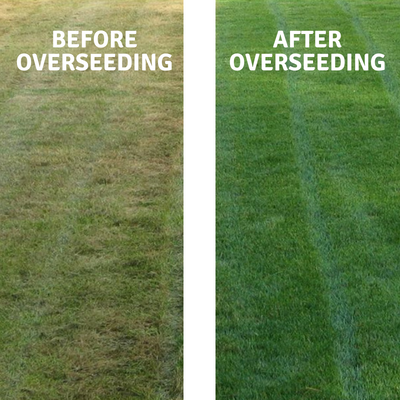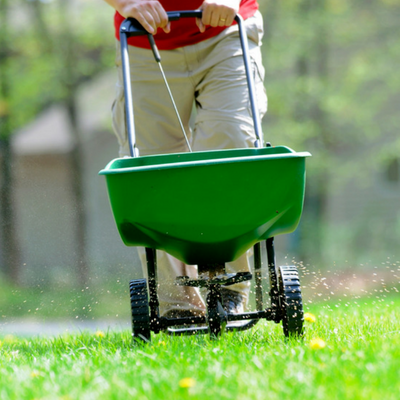Posted on July 20th, 2018

Do you feel like you’ve tried everything when it comes to keeping your lawn nice and you just can’t win?
Overseeding can give your lawn the extra boost it may need.
Sometimes, even the most well-cared for and maintained lawn will experience a failure to thrive. The weather, our families, and even our pets can eventually begin to take its toll on our grass. As a result, many home and business owners occasionally find that, even with a full fertilization and weeding program, their grass and gardens still look brown, dry, limp, and even (gasp!) bald in some areas. If that sounds like the current state of your lawn, your property may be ready for an overseeding treatment.
Overseeding is a popular and effective application that plants new grass seed directly onto an existing lawn. This non-invasive process spreads the new grass seed over the surface without tearing up your turf or disturbing the soil. When included as part of a lawn care program, overseeding can yield a multitude of significant benefits to your lawn, such as:
• Reduce soil erosion
• Enhance property appearance
• Improve grass thickness
Most importantly, with efficient sprinkler installation, overseeding not only improves the overall look and feel of your lawn now – it also strengthens the root system and nourishes plants for sustainable lawn health that fights off future pests, diseases, and drought conditions.
Of course, it’s not enough for home and business owners to know they need to overseed. To reap optimal success, it’s essential to determine when to overseed and provide other lawn care essentials such as core aeration. It’s also crucial to understand the grass type (warm and cool season) you’ll be using to drill down on the right timing for the very best results. Some general scheduling guidelines based on where you live include:
The best time to overseed lawns in the northeast typically falls in the months of August through early September. Northeast lawns do well with cool-season grasses. The best time to overseed is generally in late summer or early fall to ensure seedlings have an opportunity to take root before the colder local weather arrives.
Most residents who start the overseeding process regard this as the ideal time for overseeding cool-season grasses, which is the best time to plant grass seed in the Northeast. Many homeowners use a variety of grass species, including Kentucky bluegrass, fine fescue, and perennial ryegrass.
These grass species favor mild temperatures, which is favorable for grass seed germination. The soil is still warm from the summer, and the air is cooler, reducing the stress on newly planted grass, making it the best time to overseed lawns in the Northeast.
Here are some of the best grass seeds for overseeding in the Northeast:

The best time to overseed lawns in the Midwest also typically falls in the late summer to early fall, similar to the Northeast. It is important to note that the Midwest is another cool-season grass region. If you’re overseeding your Midwest property, schedule the process anywhere from mid-August to mid-September.
Fall often brings consistent rainfall in many parts of the Midwest, reducing the need for constant watering to keep the seeds moist. This helps ensure successful seed germination and growth. In addition, planting seeds in the summer can stress seedlings. In contrast, fall overseeding allows the grass to be established before the cold winter.
Further, there is reduced weed competition during these months. Weeds tend to slow down their growth in the fall, giving the newly seeded grass a better chance to establish itself without as much competition, making it the best time to overseed lawns in the Midwest.
Unsurprisingly, the southern states do better with warm-season grasses. The warmer temperatures mean home and business owners can overseed as early as mid-spring into the beginning of the summer.
Here are some of the best grass for overseeding in the South:
This region uses both warm and cool-season grasses. You’ll find warm-season grasses in the Southwest, where you’ll want to overseed in the early spring. The Northwest generally uses cool-season grasses, beginning the overseeding process about a month and a half before winter.
Your Turf Unlimited team has provided top-notch lawn care services in Massachusetts and New Hampshire since 1996.
Still, Have Questions About When to Overseed Your Property? We have answers! Contact Turf Unlimited today to hear more about our overseeding, aeration, and fertilization programs.